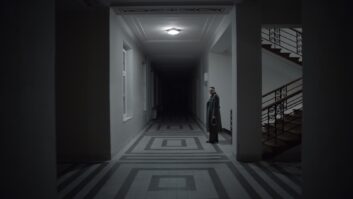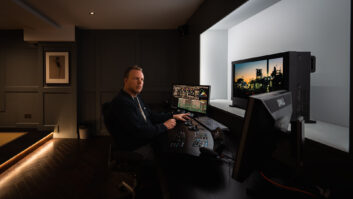What if someone told you that you inherited one trillion dollars? Most would dismiss it as a joke, which is exactly what John, a bike courier in Berlin, did when he received the news that he was the sole heir to a trillion-dollar fortune. The money came with a catch; he must restore humanity’s lost future.
While the protagonist in One Trillion Dollars faces an almost impossible task, similarly the creative team of the series, produced by W&B Television and Paramount Television International Studios based on Andreas Eschbach’s 2001 novel, worked hard to make the right decisions and implement a UHD HDR image workflow right from the outset. Cologne-based freelance colourist Felix Hüsken (BVK, AAC, CSI) worked as a colour consultant and was responsible for the final DI grade at Rotor Film, Berlin. In his role, he worked closely with DoP Yoshi Heimrath (BVK).
“When we talk about colour grading, this entails enhancing the DoP’s creative intent while ensuring the technical quality of the images. The earlier the colourist becomes involved, the better; essentially, that is in preproduction,” Hüsken states. And that is the way the team worked for One Trillion Dollars.

With a significant portion of the series set amongst the super-rich, the aim was to create a high-quality look to this exclusive world. “The story dictated that our sets reflected a high-end lifestyle, complete with designer lamps and luxury sports cars,” he recalls. “At the same time, the colours should remain as natural as possible and not contain too many artificial colour enhancements. A wide HDR colour gamut offers immense creative freedom, but it’s easy to overdo it,” Hüsken explains.
On-set grading
The deliverables were to be produced in UHD HDR with an additional SDR trim version. The series was shot on a Sony Venice camera in X-OCN ST and 23.987 fps, for a 2:1 letterboxed UHD format, according to the spec from Paramount.
While the series was shot for UHD HDR, dailies were created and exported in SDR, relying on an ACES colour-managed pipeline throughout. “I really like working with ACES, it has become a reliable industry standard for colour management, and it simply works,” Hüsken confirms.

Hüsken’s role extended to collaborating closely with the DITs/On-Set colourists. “I designed everything in DaVinci Resolve Studio and provided my project file to DIT Martin Knispel and the rest of the team, so that everyone could access all of my grading data,” he adds. “They could call me when they had a new camera or any technical changes were made.”
It wasn’t clear whether Heimrath could be present during the final grade, so the idea was to create great-looking dailies on set. “I already had worked with Yoshi, so I knew that we were on the same page when it came to the grade. We didn’t use LUTs or any constrained ourselves to only basic colour tools for the dailies grade. Instead, the dailies were graded using my complete final grade node structure and approved on set. Then I used that data and feedback for the final grade, which proved effective,” recounts Hüsken.

Flexibility and attention to detail
The ability to work flexibly from any location is also important in film production, including colour grading. “Wherever I am, I can just take out my MacBook Pro and the full DaVinci Resolve Studio software at hand, just like in the studio grading suite or at home. The only thing missing is the DaVinci Resolve Advanced Panel. I can access the same data as others in the team or link what I’ve just done back to the studio. The software is also compatible with different hardware and allows using external plugins, which makes it versatile.”
Among others, a tool that came in handy for the UHD HDR production was DaVinci Resolve Studio’s Colour Warper. Hüsken recalls, “The series offered a lot of diverse scenes and locations. There was action, drama, love, tech, finances and more. Fittingly, it felt like we’d also used every tool in the grading suite by the end, however the Colour Warper is one of Resolve’s more unique features. With it you can select a single point in an image and control the hue, saturation and luminance simultaneously, which is a more intuitive way of grading. We also used several of the included OFX plugins like lens flares, film grain, object removal, etc.”
One Trillion Dollars is now available on Paramount+ in Germany, Italy, Austria, Switzerland, France and the UK.







